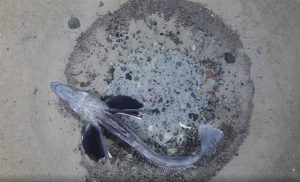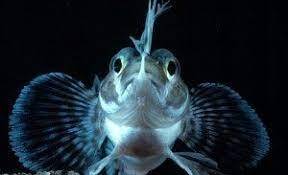
It was February 2021 when the monitors on board the German research vessel Polarstern began to show images of dozens of fish nests on their screens, which soon began to number in the hundreds. What the vessel's tow camera system reflected was the depths of the Weddell Sea . The scientists couldn't believe it. Between 420 and 535 meters deep, nest after nest, as the mission progressed, a growing excitement grew until it turned into disbelief when the researchers were able to verify that, before their eyes, on the seabed, a nest of fish was unfolding for each 3 square meters.
Sometimes more. However, the real surprise came when verifying that the area occupied by this large breeding ground for Jonah's striped drakes - Neopagetopsis ionah - covered a total area of 240 square kilometers; an area approximately the size of the island of Malta that today forms the largest fish farm known to date. And, extrapolating the density figures, it could turn out that the icefish population discovered near the Filchner ice shelf harbors up to 60 million fish, a new and notable argument for the already discussed establishment of a Marine Protected Area in the sector. Atlantic of the Southern Ocean.

Based on the images, the team was able to clearly identify the round nests about 15 centimeters deep and 75 centimeters in diameter, which were distinguished from the muddy seabed by a round central area lined with small stones. The researchers distinguished several types of them: some "active", which contained between 1,500 and 2,500 eggs and guarded in three quarters of the cases by an adult icefish and others that contained only eggs. They also found nests without laying, in the vicinity of which They could observe fish without eggs or dead.
"The idea that such a large icefish breeding area in the Weddell Sea had not been discovered previously is totally fascinating," says Purser. "Until now, striped icefish have only been detected individually or in small groups." The scientists later combined their results with oceanographic and biological data, discovering that the breeding area corresponds to the influx of warmer deep waters from the Weddell Sea toward the upper shelf. With the help of seals equipped with transmitters, the team was also able to demonstrate that the region is also a popular destination for Weddell seals, which carry out 90% of their activity in the region of nests with active fish, which they presumably They come in search of food.
It is not surprising, since researchers estimate that the biomass of the Neopagetopsis ionah colony in the area amounts to about 60 thousand tons. "With its biomass, this huge breeding area is an extremely important ecosystem for the Weddell Sea and, based on current research, is likely the most extensive breeding colony of fish discovered anywhere in the world to date." , experts report. For AWI director and deep-sea biologist Professor Antje Boetius, the current study is a sign of how urgent it is to establish marine protected areas in Antarctica.
"This great discovery shows how important it is to be able to investigate unknown ecosystems before disturbing them," he says. "Given how little known the Weddell Sea in Antarctica is, this discovery further underlines the need to establish a Marine Protected Area," he adds. To this end, the Alfred Wegener Institute has already presented a proposal for the creation of this figure of international protection that since 2016 has been supported by the European Union and its member states, as well as by other countries that are part of the International Commission for Conservation of Antarctic Marine Living Resources (CCAMLR).
“Unfortunately, the Weddell Sea Marine Protected Area has not yet been unanimously supported by all CCAMLR members,” he continues. “However, now that the location of this extraordinary breeding colony is known, both Germany and the Other CCAMLR members should ensure that future fishing activities do not take place in the area, and that this is exclusively for non-invasive scientific research. "Until now, the remoteness and difficult sea ice conditions of This southernmost area of the Weddell Sea has protected the area, but with increasing pressures on the ocean and polar regions, we should be much more ambitious with marine conservation,” he says.
Source: National Geographic https://www.nationalgeographic.com.en/nature/antarctica-found-world-largest-fish-breeding-zone-known-to-date_17759


